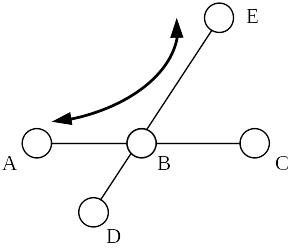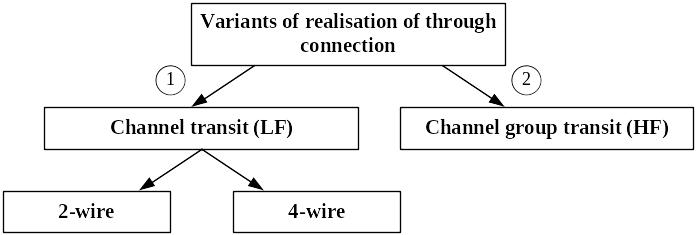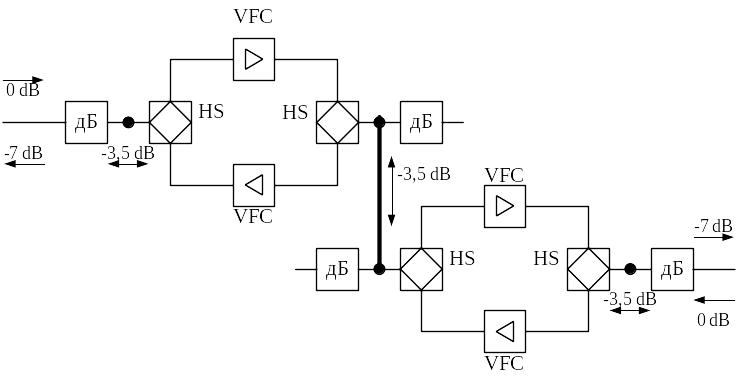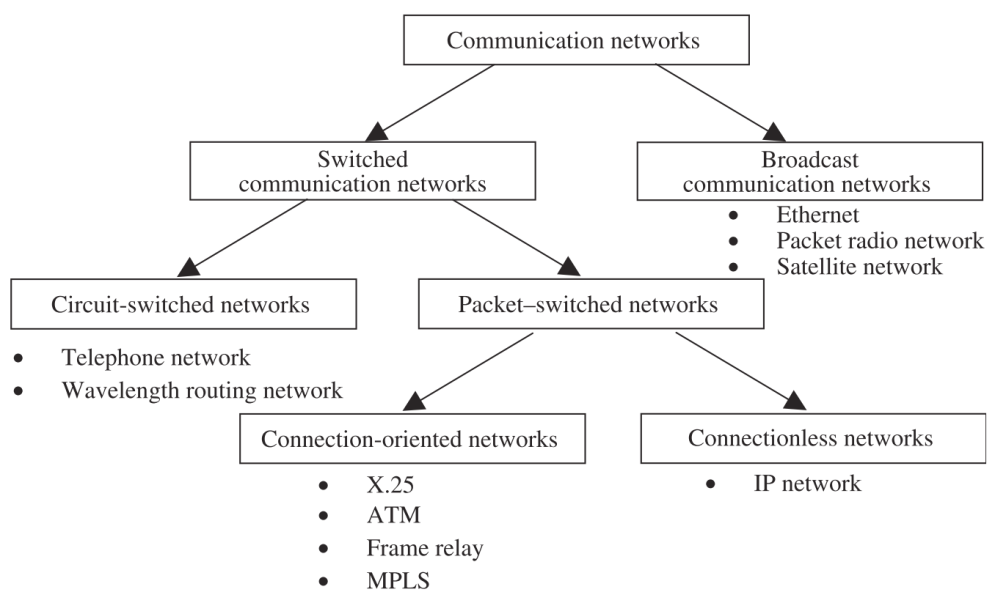
- •Table of contents
- •1 Section Telecommunication public network
- •1.1 Types of telecommunication networks
- •1.2 The basic elements of the pn (the network elements)
- •2 Section Transmission systems
- •2.1 Functions and the basic elements of the transmission systems
- •2.2 The repeater section length
- •2.3 The level diagram
- •2.4 The classification of TrS:
- •2.5 The necessity of the group signal transmission
- •3 The multiplexing methods
- •3.1 Frequency (spectral) division channeling fdc (sdc)
- •3.1.1 Filter method
- •3.1.2 Phase difference method
- •3.2 Time division channeling
- •4 Duplex organization methods
- •4.1.3 A four-wire one-band duplex
- •4. 2 Decoupling devices
- •5 Transmission channels.
- •5.1 The main parameters of vbc
- •5.2 Transit connections
- •Types of the communication networks
- •Classification of communication networks
- •6.2 A Telephone Connection
- •6.3 An atm Connection
- •6.4 An mpls Connection
- •6.5 A Wavelength Routing Optical Network Connection
5.2 Transit connections
The transit connections are used for communications organization between the nodes, which don’t have the direct communication. Example of transit connection organization.

Figure 5.3
The channel transit from MTS-1 to MTS-2 is performed in B node for the communications organization between A and D nodes. The transits can be subdivided according to the intended use into:
Permanent
Temporary

Transit connection of channels is performed in 0.3…3.4 kHz spectrum that’s why it’s sometimes called low frequency transit. It can be performed by using the 2w or 4w scheme.
2w transits can be easily performed without any additional matching devices. This connection is organized without transit (through-line) extenders. Disadvantage: presence of high number of loop systems that causes the channels stability decreasing. Unidirectional communication isn’t possible because of HS (TSets). That’s why this method is not widely used.

Figure 5.4
4w transit schemes don’t have such disadvantages. Attenuators with A = 4 – (-13) = +17 dB attenuation are used for matching of 4w channel’s output with the 4w channel’s input by the level. There is no need to use HS in transit node, so they are switched off.

Figure 5.5
Types of the communication networks
Communication networks can be classified into the following two broad categories: switched communication networks and broadcast communication networks. As shown in Figure 1.1, switched communication networks are further classified into circuit-switching networks and packet-switching networks. Circuit switching and packet switching are two different technologies that evolved over a long time. Examples of circuit-switching networks are the telephone network and the wavelength routing optical network. Examples of packet-switching networks are the IP network, ATM, frame relay, and MPLS networks.
Examples of broadcast communication networks are packet radio networks, satellite networks, and multi-access local networks (such as the Ethernet).
Packet-switching networks are further classified as connection-oriented networks and connectionless networks. Examples of connection-oriented networks are: X.25, ATM, frame relay, and MPLS. The prime example of a connectionless network is the ubiquitous IP network.
Classification of communication networks

Figure 6.1 A classification of communication networks
In a circuit-switching network, in order for two users to communicate, a circuit or a connection has to be first established by the network. Specifically, three phases are involved: circuit establishment, data transfer, and circuit disconnect. These three phases take place, for instance, when we make a phone call. Circuit establishment takes place when we dial a number. At that moment, the telephone network attempts to establish a connection to the phone of the called party. This involves finding a path to the called party, allocating a channel on each transmission link along the path, and alerting the called party. The data transfer phase follows, during which we converse with the person we called. Finally, the circuit disconnect phase takes place when we hang up. At that moment, the network tears down the connection and releases the allocated channel on each link on the path. The connection is dedicated to the two users for the duration of the call, even when no data is being sent. That is, the channel allocated on each transmission link along the path from our phone to the one we called is not shared with any other phone calls. Also, in order for the call to be established, both stations must be available at the same time.
Circuit switching is a good solution for voice, since it involves exchanging a relatively continuous flow of data. However, it is not a good solution for the transmission of bursty data; that is, data that continuously alternates between an active period and a silent period. Transmission of data only takes place when the source is in the active period. Such intermittent data transmission is typical in high-speed networks, and leads to low utilization of the circuit-switching connection.
In packet-switching networks, information is sent in packets, which are passed through the network from node to node until they reach their destination. Error and flow control procedures can be built into the network to assure reliable service. In packet switching, two different techniques (virtual circuits and datagrams) can be used.
A virtual circuit imitates circuit switching and it involves the same three phases: call setup, transfer of packets, and call termination. In call setup, a connection path is established between the sender and the receiver prior to the transmission of packets. This path, which all packets will follow, goes through the nodes of the packet-switching network. Each packet consists of a header and a payload. The header contains various fields, of which one or more are used to identify the connection that the packet is associated with. This information is used to switch the packet through the network. Unlike circuit switching, however, the channel capacity allocated on each transmission link is not dedicated to the virtual circuit. Rather, the transmission link is shared by all of the virtual circuits that pass through it. Error control assures that all packets are delivered correctly in sequence. Packet-switching networks that employ the virtual circuit switching technique are known as connection-oriented networks. Examples of such networks are: ATM, frame relay, and MPLS.
In datagrams, no connection is set up between the two users, and a user can transmit packets whenever the user wants to. Each packet consists of a header and a payload. The header typically contains a number of different fields, including the source address and the destination address. Each packet is individually routed through the network using its destination address. Since the packets are transferred separately, two successive packets transmitted from the same sender to the same receiver could conceivably follow different routes through the network. Since each packet is routed through the network individually, a datagram service can react to congestion easier. Packet-switching networks that employ datagrams are known as connectionless networks. The IP network is a prime example of a connectionless packet-switching network. A packet-switching network can be either connection-oriented or connectionless.
A broadcast network has a single communication channel that is shared by all of the stations. There are no switching nodes, as in circuit switching or packet switching. Data transmitted by one station is received by many, and often all, stations. An access control technique is used to regulate the order in which stations transmit. Packet radio networks and satellite networks are examples of a broadcast network. The most widespread example of a broadcast network is the Ethernet. (Currently, the 1-gigabit and 10-gigabit Ethernet is not used as a broadcast network. Ethernet is simply used for unidirectional point-to-point transmission between two users.)
EXAMPLES OF CONNECTIONS
